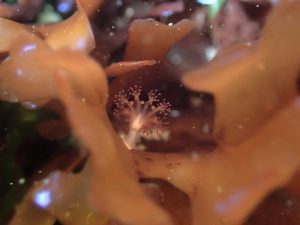National Marine Week is The Wildlife Trusts’ nationwide celebration of all things marine. Despite the name, it lasts 15 fun-filled days to allow for the variation in tide times around the UK. Whilst many will be focussing on marine megafauna (whales, dolphins, seals etc) why not celebrate with Buglife by learning about our amazing ocean invertebrates. They really are the small things that run the planet!
…blog by Kaitlyn Elverson, Buglife Community Engagement Officer
My love for jellyfish started when I had to choose a subject for my university dissertation. Being nowhere near the coast in Nottingham and following the advice that I should choose a topic I would remain interested in, I decided that jellyfish would be the perfect subject. And boy, did I remain interested. Here’s a brief dive into the world of jellyfish.
What is a jellyfish?

Jellyfish are free-floating animals that are part of the subphylum Medusozoa and wider phylum Cnidaria. They typically have long tentacles with stinging cells called nematocysts, and while some stings are very painful and deadly to humans, most of our common UK species like the Moon Jelly (Aurelia aurita), a small, pink, transparent jellyfish with short tentacles, are not as harmful.
A swarm of jellyfish is called a “bloom”, as they somewhat resemble a bed of emerging flowers; just don’t stop to smell them! Jellyfish are some of the oldest living organisms on the planet, with fossil records suggesting they’ve been around more than 500 million years.
The broader term for adult jellyfish is medusae, which refers to the bell like body shape we commonly associate with jellyfish. The medusa is part of the jellyfish’s lifecycle, referring to the adult phases of their life. Most species exist in this phase for only a few months, but the polyp stage, can be longer lived. The polyp is a small, stalked version of the jellyfish, with one end anchored to the seabed and the other free floating in the water. To become an adult jellyfish, the polyp must undergo a process called strobilation. Triggered by external changes such as light or temperature, the polyp divides it’s main body up into tiny segments which become individuals. These individuals are called ephyra, baby jellyfish, which eventually mature into full grown medusae.

There are four main classes of Medusozoan jellyfish:
- Scyphozoa or “true jellyfish”, which include species like the Moon Jelly, the Barrel Jellyfish (Rhizostoma pulmo) and the Blue Jellyfish (Cyanea lamarckii), which can all be found in UK waters. They have radial symmetry, meaning that they essentially have no forward-facing part of their body, and can detect and respond to external stimuli from any direction. They have tentacles and a central mouth.
- Cubozoa or the Box Jellyfish are, you guessed it, box-like in shape and usually quite small. They pack a huge punch, having what is considered one of the deadliest venoms in the world. Sometimes called “marine stingers” or “sea wasps”, they are predominantly found off the coast of Northern Australia and the Indo-Pacific.
- Hydrozoa medusae, which differ from Scyphozoans as they undergo budding instead of strobilation to asexually reproduce; instead of separating into many individuals from a central point, they develop from an outgrowth of the polyp and “bud”. This class contains organisms such as the Siphonophores, which are collections of different organisms working together; some parts catch prey, some reproduce, and some are responsible for movement.
- Staurozoa or Stalked jellyfish are characterized by a medusa form that is generally stuck down and their bell floating in the water.

Overall, there are more than 2000 species of jellyfish around the world, each just as weird and wonderful as the next. If you’d like to know more, the books listed below are fantastic places to start:
-
- Stung! On Jellyfish Blooms and the Future of the Ocean by Lisa-Ann Gershwin
- Jellyfish: A Natural History by Lisa-Ann Gershwin